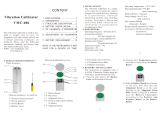
771
Calibration Manual
14
Temperature Adjustment Procedure
The percentage display should show t23, if not:
1. Press for >1 second until t23 appears.
2. Wait at least 60 seconds for the internal temperature to balance.
3. Press to adjust the temperature.
Low Range Adjustment Procedure
1. Clamp the Meter’s current clamp around an insulated 18-gauge copper wire
with 6-inch diameter. Current flow should be in the direction of the arrow on
the current clamp.
2. Press <1 second until CAL 20 appears on percentage display.
3. Output 0 µA dc from the calibrator.
4. Wait at least 15 seconds for the Meter’s internal circuits to stabilize.
5. Press on the Meter to zero the reading.
6. Output 20 mA dc from the calibrator.
7. Wait at least 15 seconds for the Meter’s internal circuits to stabilize.
8. Press on the Meter to adjust the positive gain.
9. Output -20 mA dc from the calibrator.
10. Wait at least 15 seconds for the Meter’s internal circuits to stabilize.
11. Press on the Meter to adjust the negative gain.
High Range Adjustment Procedure
1. Clamp the Meter’s current clamp around an insulated 18-gauge, copper wire,
with 6-inch diameter. Current flow should be in the direction of the arrow on
the current clamp.
2. Press <1 second until CAL 100 appears on percentage display.
3. Output 0 µA dc from the calibrator.
4. Wait at least 15 seconds for the Meter’s internal circuits to stabilize.
5. Press on the Meter to zero the reading.
6. Output 100 mA dc from the calibrator.
7. Wait at least 15 seconds for the Meter’s internal circuits to stabilize.
8. Press on the Meter to adjust the positive gain.
9. Output -100 mA dc from the calibrator.
10. Wait at least 15 seconds for the Meter’s internal circuits to stabilize.
11. Press on the Meter to adjust the negative gain.
12. If the Meter’s current clamp has NOT been replaced, press the calibration
button to exit the calibration mode.
Note
The following procedure is not required unless the Meter’s current
clamp has been replaced.




















